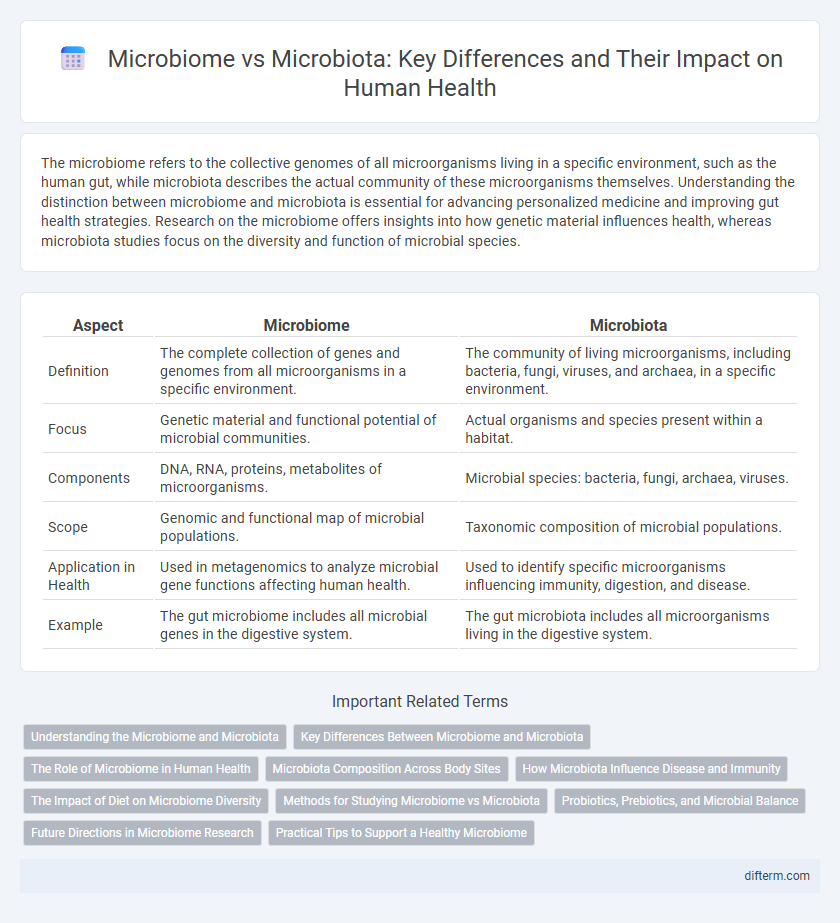The microbiome refers to the collective genomes of all microorganisms living in a specific environment, such as the human gut, while microbiota describes the actual community of these microorganisms themselves. Understanding the distinction between microbiome and microbiota is essential for advancing personalized medicine and improving gut health strategies. Research on the microbiome offers insights into how genetic material influences health, whereas microbiota studies focus on the diversity and function of microbial species.
Table of Comparison
| Aspect | Microbiome | Microbiota |
|---|---|---|
| Definition | The complete collection of genes and genomes from all microorganisms in a specific environment. | The community of living microorganisms, including bacteria, fungi, viruses, and archaea, in a specific environment. |
| Focus | Genetic material and functional potential of microbial communities. | Actual organisms and species present within a habitat. |
| Components | DNA, RNA, proteins, metabolites of microorganisms. | Microbial species: bacteria, fungi, archaea, viruses. |
| Scope | Genomic and functional map of microbial populations. | Taxonomic composition of microbial populations. |
| Application in Health | Used in metagenomics to analyze microbial gene functions affecting human health. | Used to identify specific microorganisms influencing immunity, digestion, and disease. |
| Example | The gut microbiome includes all microbial genes in the digestive system. | The gut microbiota includes all microorganisms living in the digestive system. |
Understanding the Microbiome and Microbiota
The microbiome refers to the collective genomes of microorganisms living in a specific environment, such as the human gut, while microbiota denotes the actual community of these microorganisms, including bacteria, fungi, viruses, and archaea. Understanding the microbiome involves studying the genetic potential and functions of these microbial communities, which influence digestion, immune response, and overall health. Advances in metagenomics and sequencing technologies enable detailed analysis of microbiota composition and its dynamic interactions within the host.
Key Differences Between Microbiome and Microbiota
The microbiome refers to the collective genomes of all microorganisms, including bacteria, fungi, viruses, and their genes within a specific environment, while the microbiota denotes the actual community of living microorganisms themselves. Key differences lie in the scope: microbiota emphasizes the organisms present, whereas microbiome encompasses both the organisms and their genetic material. Understanding these distinctions is crucial for advancing research in gut health, immune response, and disease prevention.
The Role of Microbiome in Human Health
The microbiome, comprising the collective genomes of all microorganisms inhabiting the human body, plays a crucial role in regulating immune function, digestion, and metabolic processes. Unlike microbiota, which refers specifically to the community of microorganisms themselves, the microbiome encompasses their genetic material and interactions with the host. Disruptions in the microbiome balance are linked to conditions such as inflammatory bowel disease, obesity, and mental health disorders, highlighting its significance in maintaining overall human health.
Microbiota Composition Across Body Sites
Microbiota refers to the diverse community of microorganisms, including bacteria, viruses, fungi, and archaea, residing on and within different body sites such as the gut, skin, oral cavity, and respiratory tract. Microbiome encompasses the collective genomes and metabolic activities of these microbiota, influencing human health through immune modulation, digestion, and pathogen resistance. Variations in microbiota composition across body sites reflect site-specific environmental factors, nutrient availability, and host interactions, contributing to distinct microbial ecosystems essential for maintaining local and systemic homeostasis.
How Microbiota Influence Disease and Immunity
Microbiota, the complex communities of microorganisms residing in and on the human body, play a crucial role in influencing disease susceptibility and immune system function. Dysbiosis, an imbalance in microbiota composition, has been linked to conditions such as inflammatory bowel disease, allergies, and autoimmune disorders by disrupting immune homeostasis. These microbial populations interact with host immune cells through metabolic and signaling pathways, enhancing immune defense mechanisms and maintaining mucosal barrier integrity.
The Impact of Diet on Microbiome Diversity
Diet significantly influences microbiome diversity by shaping the composition and function of gut microorganisms, crucial for metabolic and immune health. A fiber-rich diet promotes beneficial bacteria growth, enhancing short-chain fatty acid production that supports intestinal barrier integrity and reduces inflammation. Conversely, high-fat and high-sugar diets diminish microbiome diversity, contributing to dysbiosis linked to obesity, diabetes, and cardiovascular disease.
Methods for Studying Microbiome vs Microbiota
Studying the microbiome involves metagenomic sequencing techniques that analyze collective genetic material from multiple microbial communities, providing insights into their functional potential and interactions. Microbiota research often utilizes culture-based methods and 16S rRNA gene sequencing to identify and classify individual microbial species within a specific environment. Advanced bioinformatics tools and multi-omics approaches enhance understanding of microbial diversity, dynamics, and their impact on host health in both microbiome and microbiota studies.
Probiotics, Prebiotics, and Microbial Balance
Probiotics are live beneficial bacteria that enhance the microbiota, the community of microorganisms residing in the human gut, while prebiotics are non-digestible fibers that nourish these microbes, promoting microbial balance. Maintaining a healthy microbiome--the functional ecosystem of these microbes and their genetic material--is crucial for digestion, immunity, and overall health. Imbalances in microbial populations, known as dysbiosis, can lead to inflammatory diseases, highlighting the importance of targeted probiotic and prebiotic intake for restoring gut homeostasis.
Future Directions in Microbiome Research
Future directions in microbiome research emphasize understanding the complex interactions between the microbiota--the diverse communities of microorganisms residing in the human body--and their collective functions impacting health and disease. Advances in metagenomics and multi-omics technologies enable precise characterization of microbial genes, metabolites, and host-microbe interactions, fostering personalized medicine approaches. Expanding knowledge of microbiome dynamics holds promise for developing targeted therapies for disorders such as inflammatory bowel disease, metabolic syndromes, and neurodegenerative conditions.
Practical Tips to Support a Healthy Microbiome
Maintaining a healthy microbiome involves prioritizing diverse, fiber-rich foods such as vegetables, fruits, and whole grains to nourish beneficial bacteria. Probiotic-rich foods like yogurt, kefir, and fermented vegetables introduce live microorganisms that support microbiota balance. Minimizing antibiotic overuse and managing stress also contribute to sustaining a resilient microbial ecosystem essential for immune function and digestion.
Microbiome vs Microbiota Infographic

 difterm.com
difterm.com